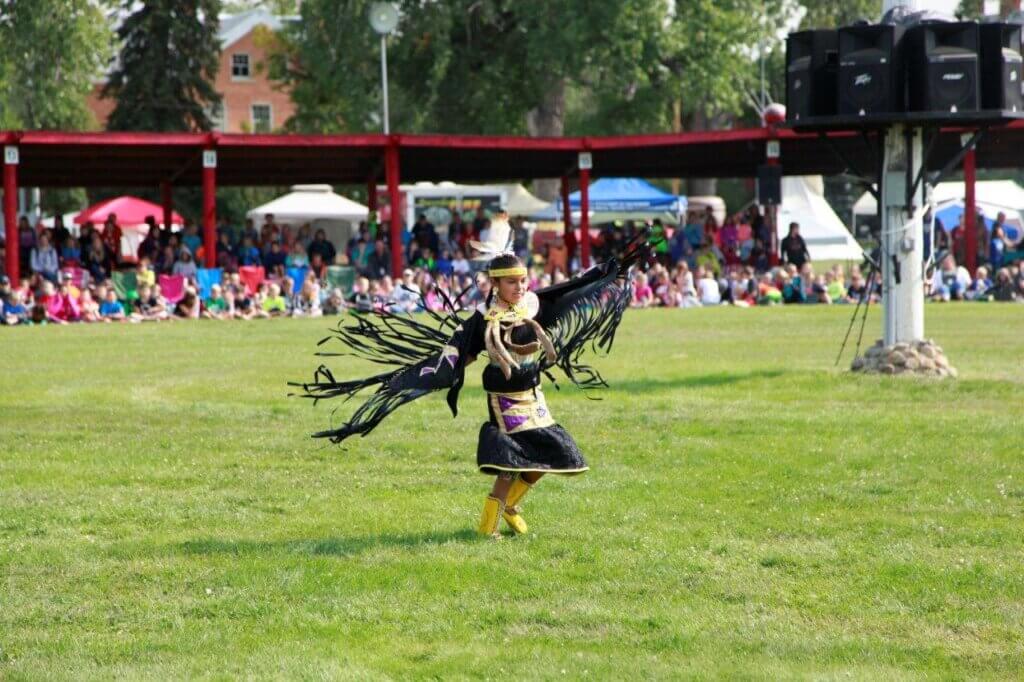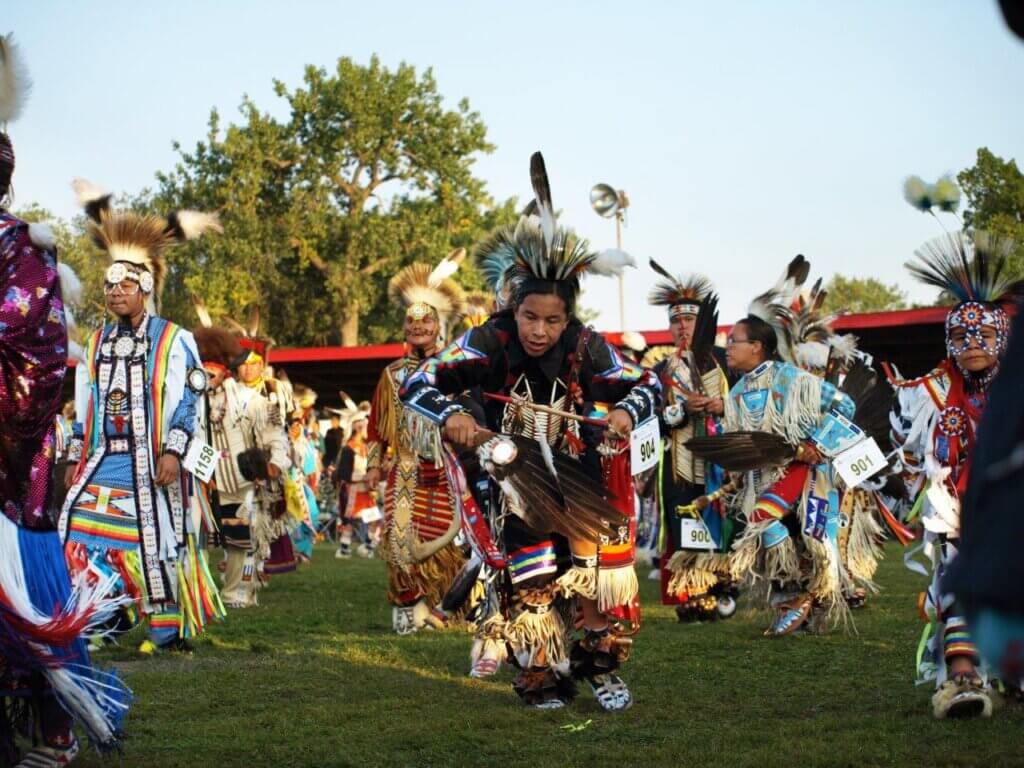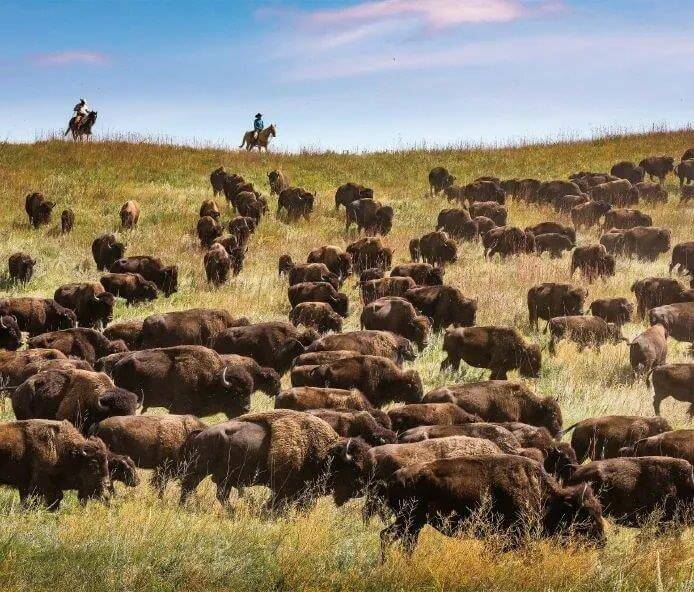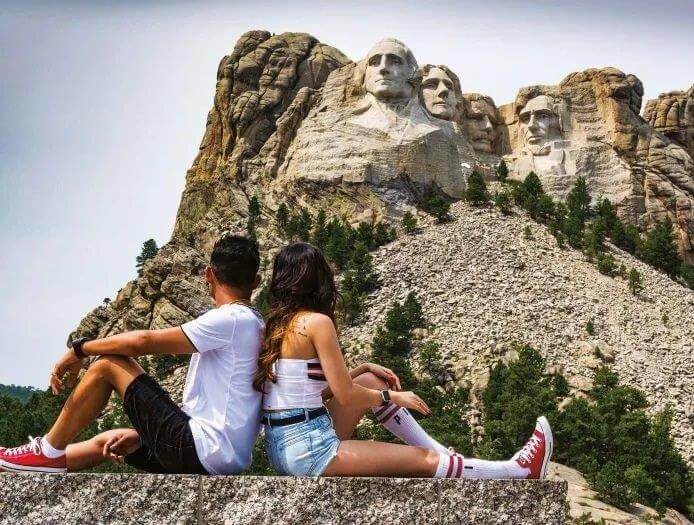The following is excerpted from the “Guide to Tribal Nations”—the Oceti Sakowin Homelands—developed by the tribes of the South Dakota Native Tourism Alliance.

A South Dakota Powwow inspires dancers. Photo courtesy TravelSouthDakota.
Welcome to the land of the Lakota, Dakota and Nakota. There are 9 Native American tribes that call South Dakota home and each of them has a unique story to tell.
Working together, they welcome visitors into their communities in order to educate and share.
When visiting Native communities, you will experience genuine hospitality, discover authentic art and hear about the fascinating history and unique culture of the people known by many as ‘Sioux.’*
People of the Great Sioux Nation prefer the terms Lakota (meaning Friend, Ally, or Brother People), Dakota and Nakota when referring to themselves as a people and a nation.
These are the names of the group’s different dialects, regions and economies.
The Powwow

Women’s fancy shawl dance in Bismarck, ND. Photo courtesy ND Tourism.
Colorful finery, elaborate feather-work and intricate beadwork describe the visual atmosphere of a powwow or ‘wacipi’ (pronounced wah-CHEE-pee; Lakota, Dakota and Nakota for ‘they dance).
Spirited drumming and singing fill the air as dancers complete their fancy footwork.

The drummers keep up the rhythm for dancers at United Tribes Powwow, Bismarck. Photo ND Tourism.
Many of today’s powwows feature competitions in categories such as traditional, fancy and jingle-dress dancing.
During the intertribal dance, spectators have a chance to enter the dance ring.
Vendors at powwows provide an opportunity for visitors to sample foods like Indian tacos, fry bread and ‘wojapi,’ a fruit sauce or jam.
The wacipi, as practiced in the Plains region, is a social event which can last from one to several days.
It is a time when Lakota, Dakota and Nakota tribal people conduct honorings, giveaways and family gatherings. Friends meet, camp, visit and reconnect as tribal nations.
During the summer months, the celebration is usually held outdoors, with a shade or covered area where the audience and dancers sit.
The center area or arena is reserved for the dancing. Dances are either for men or women and competitions are divided into age categories. The dancers move in a clockwise direction, which represents the circle of unity and the never-ending cycle of life.
Singers are usually under or adjacent to the shade or covered area between the audience and the dance arena.
Powwow singers and drummers play a very important part of the celebration, providing rhythm for the dancers. They sing many types of songs, including honor and family, war and conquest, jo, encouragement, humor and mourning.
Attire worn by a dancer is called ‘regalia’ and should not be referred to as a costume.
Development of a dancer’s regalia often takes years to create and may include gifts which have deep meaning.
Catch the spirit at one of these or many other wacipi celebrations across the state.
When attending please remember to be respectful.

Dancer at United Tribes International Powwow in Bismarck. Photo ND Tourism.
Visitor Guidelines
South Dakota’s tribal community’s welcome visitors. The following guidelines will help travelers enjoy their visit while honoring the people, lands and culture.
A visit to tribal administration offices for additional information is recommended.
Native American communities comprise a diversity of tribal members who practice varying degrees of tradition.
Traditionalists expect tribal members and visitors to conduct themselves in a manner that is respectful of tribal religion and ceremonies.
With this in mind it must be recognized that a code of conduct practiced at one community or event may not be appropriate at another.
Some communities may have policies about picture-taking, sketching and audio/video recording. Visitors should always ask for permission.
When attending ceremonial events, please prioritize appropriate dress, speech and behavior. An unkempt appearance can be offensive where many people wear their finest.
Do not disturb sites that contain devotions or offerings. These include pipes, bundles, ties, flags of colored material, food offerings and other items. These sites are considered sacred.
The ancestors of today’s tribes left many artifacts and ruins behind. Resist the impulse to pick up souvenirs.
Native American remains and artifacts are protected federally by the Native American Graves Protection and Repatriation Act, which carries stiff penalties for violations.
*The US government officially recognized the Lakota as ‘Sioux’ in 1825 and has applied this name to the Lakota, Dakota and Nakota in official documents ever since.
The term ‘Sioux’ is a fragment of the French and Ojibwa word ‘nadouessioux’ which is believed to be a derogatory term meaning ‘little snakes.’ The name may have resulted from a history of territorial conflicts between the Lakota, Dakota, Nakota and the Ojibwas.
The word ‘Sioux’ appears in this publication when necessary, but efforts were made to use the more accepted terms of Lakota, Dakota and Nakota. As this guide was taken from many sources [including oral histories] there are inconsistencies in the spelling of Lakota, Dakota and Nakota words.

A lone buffalo bull surveys the dramatic peaks in the SD Badlands. The rugged beauty of the Badlands draws visitors from around the world. These striking geologic deposits contain one of the world’s richest fossil beds. Ancient horses and rhinos once roamed here. Photo TravelSouthDakota.
Watch for buffalo herds as you travel across the open prairies.
Herds can also be viewed at Bear Butte State Park, Custer State Park, Wind Cave National Park and Badlands National Park [all in South Dakota].
Please observe buffalo at a distance.

Two riders help to bring in the herd for the annual Custer State Park Round up. TravelSouthDakota.
Tribal Contact
[For more information on powwows and local events year around, contact the following Tribal Headquarters.]

Young visitors take a close look at the famous faces on Mt. Rushmore. TravelSouthDakota.
Cheyenne River Sioux Tribe
PO Box 590, Eagle Butte, SD 57625
605-964-4155
Crow Creek Sioux Tribe
PO Box 50, Fort Thompson, SD 57339
605-245-2221
Flandreau Santee Sioux Tribe
PO Bos 283, Flandreau SD 57028-0283
605-997-3891
Lower Brule Sioux Tribe
PO Box 187, Lower Brule, SD 57548
605-473-5561
Oglala Sioux Tribe
PO Box 2070, Pine Ridge, SD 57770
605-867-5821
Rosebud Sioux Tribe
PO Box 430, Rosebud, SD 57570
605-747=2381
Sisseton Wahpeton Oyate
PO Box 509, Agency Village, SD 57262
605-698-3911
Standing Rock Sioux Tribe
PO Box D, Fort Yates, ND 58538
701-854-8500
Yankton Sioux Tribe
PO Box 1153, Wagner, SD 57380
605-384-3641
Regional Tourism
Black Hills & Badlands
1851 Discovery Circle, Rapid City, SD 57701
605-355-3600
BlackHillsBadlands.com
Glacial Lakes & Prairies
1200 33rd St SE #314. Watertown, SD 57201
605-886-7305
SDGLacialLakes.com
Southeast South Dakota
317 Broadway, Suite 7, Yankton, SD 57078
605-665-2435
SoutheastSouthDakota.com
South Dakota Missouri River
20207 South Dakota Highway 1804
Pierre, SD 57501
605-224-4617
SDMissouriRiver.com
Excerpted from “A Guide to Tribal Nations—Oceti Sakowin Homelands”—developed by the 9 Tribal Nations of South Dakota and published by TravelSouthDakota.com, SD Dept of Tourism, Pierre, May 2022. Reprinted with Permission.

Francie M Berg
Author of the Buffalo Tales &Trails blog


